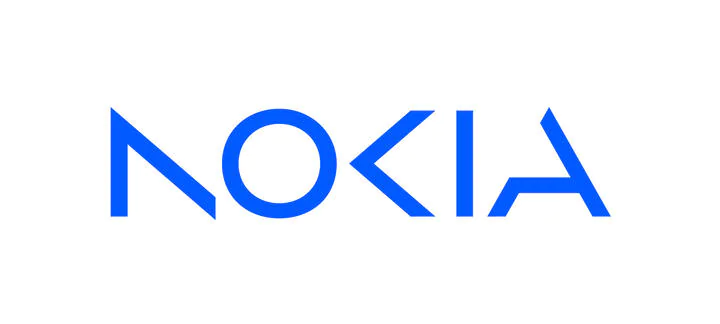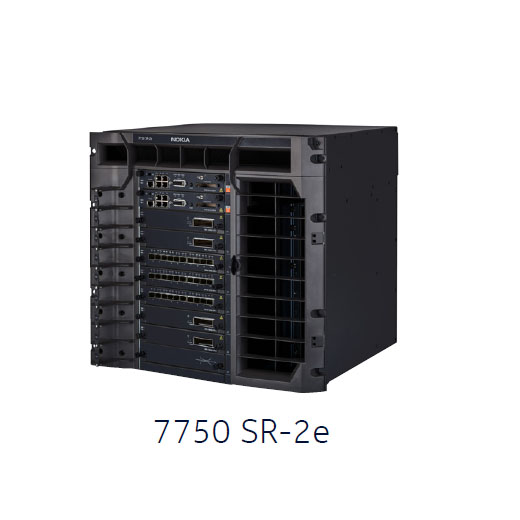Nokia 7750 SR-2e
Service Router
For service providers the Nokia 7750 SR-2e is deployed in WAN and aggregation networks to support multiple services and functions, including aggregation, Broadband Network Gateway (BNG), mobile backhaul (IP anyhaul) and provider edge (PE) for the delivery of advanced residential, mobile and enterprise services. For webscale companies and enterprises, the Nokia 7750 SR-2e provides high-performance IP routing, including connectivity to data center, internet and WAN applications.
Nokia 7750 SR Series Product Family
The 7750 SR-2e is based on the Nokia FP3 network processing silicon and scales system capacity from 200 Gb/s full duplex (FD) to 600 Gb/s FD. To extend the network edge closer to end users, the 7750 SR-2e has the scale to support multiple services and functions on a common platform. The 7750 SR-2e’s innovative NEBS-compliant front-to-back thermal design provides the foundation for future growth and delivers investment protection.
The 7750 SR-2e delivers high-density Gigabit Ethernet (GE), 10GE, 25GE and 100GE interfaces with breakout options and is ideally suited for GE and 10GE fan-out in subscribed and over-subscribed access and aggregation networks. With 100GE interfaces, the 7750 SR-2e can scale access and aggregation networks in step with evolving traffic demands for years to come.
Features & Benefits
-
The Nokia 7750 SR-2e leverages the Nokia FP3, which combines a disaggregated chipset architecture and a flexible memory design to provide deterministic packet forwarding performance even when complex processing-intensive operations are required. With the FP3 traffic manager, buffering is always deterministic and does not degrade or cause control plane discards if the buffer rate increases.
Comprehensive features
- Nokia’s feature-rich 64-bit Service Router Operating System (SR OS) addresses the full spectrum of IP routing requirements. With comprehensive QoS, IP/MPLS, segment routing and model-driven management features, the Nokia 7750 SR-2e has the capabilities and tools to define and deliver the most stringent SLAs and end-user quality of experience (QoE) requirements. It supports thousands of IP flows and access control lists with high performance and scale even when multiple advanced features are enabled concurrently. Leveraging SR OS, the Nokia 7750 SR-2e supports the following value-added services and network functions through the Integrated Services Adapter (ISA): Application Assurance (AA), Layer 7 stateful firewall, Carrier Grade - Network Address Translation (CG-NAT), L2TP Network Server (LNS), Dual Stack Lite (DS Lite) Address Family Transition Router(AFTR) services, IPsec, IP tunneling, Wireless LAN Gateway (WLAN GW) and advanced video services.
- The comprehensive features of the Nokia SR OS enable the Nokia 7750 SR-2e to support a full array of IP network functions and services. Service providers can use the Nokia 7750 SR-2e in WAN and aggregation networks supporting multiple network roles, including: Broadband Network Gateway (BNG) for residential subscriber management; provider edge (PE) router for MPLS-enabled enterprise VPN, internet access and cloud services and data center interconnect; mobile applications, including as an aggregation router for 3G, 4G and 5G backhaul, a WLAN gateway for Wi-Fi® network aggregation, and a security gateway for securing backhaul networks. For webscale companies, the Nokia 7750 SR-2e delivers leading features for data center aggregation, gateway and interconnect, along with PoP edge and internet/peering functions. For enterprises, the Nokia 7750 SR-e provides highperformance IP routing for cloud, data center and WAN applications.
- To simplify and automate network operations, the 7750 SR-2e enables model-driven network element management through the Nokia SR OS. YANG-based data modeling delivers the foundation for programmability and model-driven interface support includes NETCONF, gRPC (gNMI and gNOI) and the Model-Driven CLI (MD-CLI). The Nokia Network Services Platform (NSP) also supports these interfaces using YANG models to customize automation for operational use cases.
Deterministic performance
Versatile platform
Model-driven management







